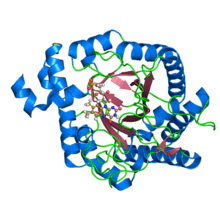NADPH dehydrogenase
| NADPH dehydrogenase | |||||||||
|---|---|---|---|---|---|---|---|---|---|
 | |||||||||
| Identifiers | |||||||||
| EC number | 1.6.99.1 | ||||||||
| CAS number | 9001-68-7 | ||||||||
| Databases | |||||||||
| IntEnz | IntEnz view | ||||||||
| BRENDA | BRENDA entry | ||||||||
| ExPASy | NiceZyme view | ||||||||
| KEGG | KEGG entry | ||||||||
| MetaCyc | metabolic pathway | ||||||||
| PRIAM | profile | ||||||||
| PDB structures | RCSB PDB PDBe PDBsum | ||||||||
| Gene Ontology | AmiGO / EGO | ||||||||
| |||||||||
In enzymology, a NADPH dehydrogenase (EC 1.6.99.1) is an enzyme that catalyzes the chemical reaction
- NADPH + H+ + acceptor
 NADP+ + reduced acceptor
NADP+ + reduced acceptor
The 3 substrates of this enzyme are NADPH, H+, and acceptor, whereas its two products are NADP+ and reduced acceptor.
This enzyme belongs to the family of oxidoreductases, specifically those acting on NADH or NADPH with other acceptors. The systematic name of this enzyme class is NADPH:acceptor oxidoreductase. Other names in common use include NADPH2 diaphorase, NADPH diaphorase, OYE, diaphorase, dihydronicotinamide adenine dinucleotide phosphate dehydrogenase, NADPH-dehydrogenase, NADPH-diaphorase, NADPH2-dehydrogenase, old yellow enzyme, reduced nicotinamide adenine dinucleotide phosphate dehydrogenase, TPNH dehydrogenase, TPNH-diaphorase, triphosphopyridine diaphorase, triphosphopyridine nucleotide diaphorase, NADPH2 dehydrogenase, and NADPH:(acceptor) oxidoreductase. It has 2 cofactors: FAD, and FMN.
NADPH is produced by the "Malate dehydrogenase (oxaloacetate-decarboxylating) (NADP+)" for the 60% and by the pentose phosphate pathway (also knew as "Shunt of pentoses") for the 40% .
Role in metabolism: The mean role of NADPH in human organism is the synthesis of lipids and the detoxification of the organism, in collaboration with the Cytochrome P450 to produce some ROS (Reactives Oxygen Species).
References
- Boyer, P.D., Lardy, H. and Myrback, K. (Eds.), The Enzymes, 2nd ed., vol. 7, Academic Press, New York, 1963, p. 477-494.
- AVRON M, JAGENDORF AT (1957). "Some further investigations on chloroplast TPNH diaphorase". Arch. Biochem. Biophys. 72 (1): 17–24. doi:10.1016/0003-9861(57)90169-8. PMID 13471057.
- Jagendorf AT (1963). "Chloroplast TPNH diaphorase". Methods Enzymol. 6: 430–434. doi:10.1016/0076-6879(63)06200-5.
- Theorell H (1935). "Das gelbe Oxydationsferment". Biochem. Z. 278: 263–290.
- Theorell H and Akesson A (1956). "Molecular weight and FMN content of crystalline "old yellow enzyme"". Arch. Biochem. Biophys. 65 (1): 439–448. doi:10.1016/0003-9861(56)90204-1. PMID 13373435.
- Walter F. Boron, Emile L. Boulpaep (2008). Medical Physiology.